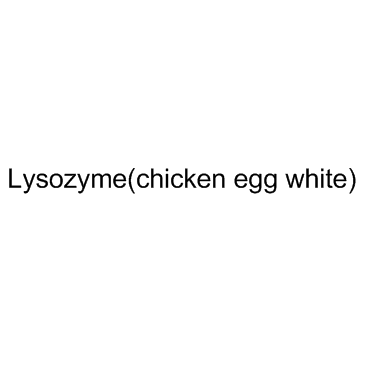Lysozyme

Lysozyme structure
|
Common Name | Lysozyme | ||
|---|---|---|---|---|
| CAS Number | 12650-88-3 | Molecular Weight | 2899.27014 | |
| Density | N/A | Boiling Point | N/A | |
| Molecular Formula | C15H20O4 | Melting Point | N/A | |
| MSDS | USA | Flash Point | N/A | |
|
A yeast display immunoprecipitation method for efficient isolation and characterization of antigens
J. Immunol. Methods 341(1-2) , 117-26, (2009) Yeast antibody display has found a wide variety of applications including antibody affinity maturation, epitope mapping, and library screening. Here we report a yeast display immunoprecipitation (YDIP) technique that employs yeast cells displaying single-chai... |
|
|
Sequential separation of lysozyme, ovomucin, ovotransferrin, and ovalbumin from egg white.
Poult. Sci. 93(4) , 1001-9, (2014) Ovalbumin, ovotransferrin, ovomucin, and lysozyme are a few of the egg white proteins that can be used as functional components. The objective of this study was to develop a simple, sequential separation method for multiple proteins from egg white. Separated ... |
|
|
Rab8a vesicles regulate Wnt ligand delivery and Paneth cell maturation at the intestinal stem cell niche.
Development 142 , 2147-62, (2015) Communication between stem and niche supporting cells maintains the homeostasis of adult tissues. Wnt signaling is a crucial regulator of the stem cell niche, but the mechanism that governs Wnt ligand delivery in this compartment has not been fully investigat... |
|
|
One-step production of protein-loaded PLGA microparticles via spray drying using 3-fluid nozzle.
Pharm. Res. 31(8) , 1967-77, (2014) The aim of this study was to investigate the potential of using a spray-dryer equipped with a 3-fluid nozzle to microencapsulate protein drugs into polymeric microparticles.Lysozyme and PLGA were used as a model protein and a model polymer, respectively. The ... |
|
|
Identification of Key Factors Involved in the Biosorption of Patulin by Inactivated Lactic Acid Bacteria (LAB) Cells.
PLoS ONE 10 , e0143431, (2015) The purpose of this study was to identify the key factors involved in patulin adsorption by heat-inactivated lactic acid bacteria (LAB) cells. For preventing bacterial contamination, a sterilization process was involved in the adsorption process. The effects ... |
|
|
Lysozyme as a recognition element for monitoring of bacterial population.
Talanta 146 , 299-302, (2015) Bacterial infections remain a significant challenge in biomedicine and environment safety. Increasing worldwide demand for point-of-care techniques and increasing concern on their safe development and use, require a simple and sensitive bioanalysis for pathog... |
|
|
Refolding of SDS-denatured proteins using amphipathic cosolvents and osmolytes.
Curr. Protoc. Protein Sci. Chapter 28 , Unit28.5, (2013) Currently, the investigation of protein refolding processes involves several time-consuming stages that require large amounts of protein and costly chemicals. Consequently, there is great interest in developing new approaches to the study of protein renaturat... |
|
|
Cpf1 is a single RNA-guided endonuclease of a class 2 CRISPR-Cas system.
Cell , doi:10.1016/j.cell.2015.09.038, (2015) The microbial adaptive immune system CRISPR mediates defense against foreign genetic elements through two classes of RNA-guided nuclease effectors. Class 1 effectors utilize multi-protein complexes, whereas class 2 effectors rely on single-component effector ... |
|
|
Application of circular dichroism and magnetic circular dichroism for assessing biopharmaceuticals formulations photo-stability and small ligands binding properties.
Int. J. Pharm. 480(1-2) , 84-91, (2015) Synchrotron radiation circular dichroism (SRCD) is a powerful tool for photo-stability assessment of proteins. Recently our research has been interested in applying SRCD to develop screening methodologies for accelerated photo-stability assessment of monoclon... |
|
|
Inhibition of lung tumor colonization and cell migration with the disintegrin crotatroxin 2 isolated from the venom of Crotalus atrox.
Toxicon 51(7) , 1186-96, (2008) Disintegrins are low molecular weight proteins (4-15 kDa) with an RGD binding region at their binding loop. Disintegrin and disintegrin-like proteins are found in the venom of four families of snakes: Atractaspididae, Elapidae, Viperidae, and Colubridae. This... |